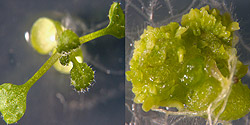On the Trail of Cell Memory in Plants
7 October 2010

Plants and humans use a similar mechanism to enable cells to pass the information on their genetic fate to their daughter cells. Biologists at Heidelberg University made this surprising discovery during experiments on mouse-ear cress, the “model plant” of molecular biology. Structural similarities came to light between two plant proteins and a human protein that affects cell memory. This led the research team under the direction of Dr. Myriam Calonje to new insights into how the information on the specific gene program in growing tissues is passed down to new generations of cells. The results are being published in the journal “Current Biology”.
It all began with the discovery of a mouse-ear cress (Arabidopsis thaliana) mutant plant whose cellular memory functions were disturbed. The plant exhibited a significant number of alterations. Among them, individual regions of the seedling develop embryo-like structures shortly after germination. In molecular genetic studies the scientists revealed them to be somatic embryos, i.e., embryos formed from cells that were already differentiated. As a result, the daughter cells receive no information on the fate of the previous cell generation and they start again with the development programme.
The Heidelberg researchers were able to make out two genes whose defect is responsible for this disruption. Both genes code two proteins that share structural similarities with the human BMI1 protein. This protein is part of a molecular mechanism designated as the cellular memory. “The mouse-ear cress cellular memory mechanism is very similar to the human one, even though part of the genes involved was replaced over the course of evolution”, explains Dr. Calonje.
Cooperating research partners in Madrid have verified that the plant BMI1 protein, like its human relative, chemically marks significant components of the inherited material, known as histones. This results in the gene being “turned off” from a certain point on. This special marking can be inherited by the daughter cells generated by cell division without changing the DNA code. That means that the genes found in Arabidopsis enable the cells to pass on the information about their genetic fate to the next cell generation.
Note to editorial staff:
Digital images are available from the press office.
Original publication:
Bratzel et al.: Keeping Cell Identity in Arabidopsis Requires PRC1 RING-Finger Homologs that Catalyze H2A Monoubiquitination, Current Biology (2010), doi:10.1016/j.cub.2010.09.046
Contact:
Dr. Myriam Calonje
Institute for Plant Science
Department of Biodiversity and Plant Systematics
Phone (06221) 54-4635
mcalonje@hip.uni-heidelberg.de
Communications and Marketing
Press Office, phone (06221) 54-2311
presse@rektorat.uni-heidelberg.de

